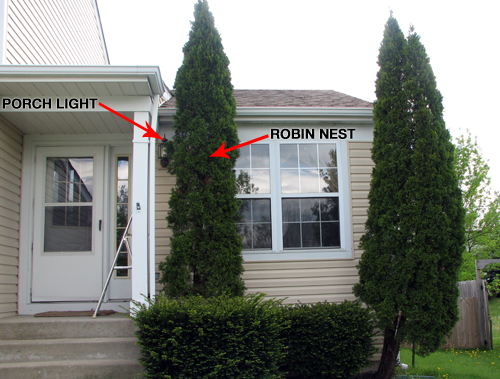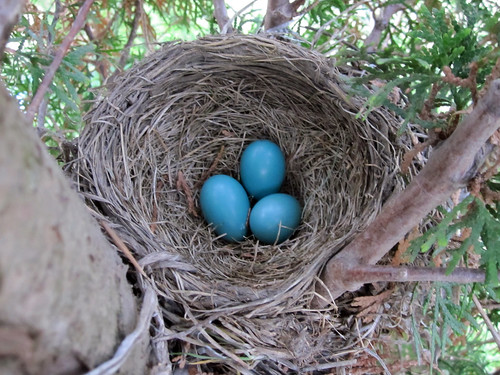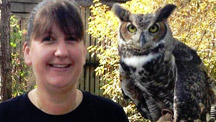We have nesting American Robins in our front arborvitae again this spring. Last year the nest was constructed from scratch; two babies fledged. Here’s a picture from last year which shows the location of the nest.

This year, I first noticed activity in the nest on April 20th, when the female robin was making frequent visits to the nest. She was bringing in soft grasses and mud to reline the existing nest, which was in good shape. I looked inside the nest on April 22nd; it was empty. We were away from April 23rd to May 1st, so the next time I could check the nest was on May 2nd, when I found four eggs.
According to the Birds of North America Online, American Robins lay one egg per day. The incubation period from the date of the last egg being laid varies from 12 to 14 days. The fourth egg could have been laid any time between April 26th and May 1st. Therefore the window I’d expect the eggs to hatch would be from May 8th to May 14th.
Yesterday, I didn’t notice any increased activity at the nest site. The female was seen on the eggs more often than not, but in the early afternoon when I had a peek from our living room I saw the female was away. I took her break time as a quick chance to peek inside the nest. I was very surprised at what I found.
I am very curious about what happened to the fourth egg. There is no trace of it underneath the nest or in the branches below the nest. American Robins are known to have the ability to recognize a Brown-headed Cowbird (a brood parasite species) egg when it is laid in their nest. The robin will puncture the intruding egg and remove it. I wonder if the nest was used by a cowbird and one of the robin eggs was accidentally lost when the cowbird egg was removed? It’s also possible an egg was predated by a crow. I guess I’ll never know. So now, like last year, we are waiting for three eggs to hatch.
Again this year I’m entering the nest data in the online citizen scientist database at Cornell’s Nestwatch. If you’ve got nesting birds on your property, consider observing the activity and entering your findings in the Nestwatch database. It’s free, fun, and educational, and it helps ornithologists (and the birds) too!





